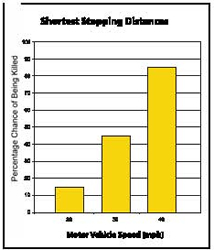U.S. Department of Transportation
Federal Highway Administration
1200 New Jersey Avenue, SE
Washington, DC 20590
202-366-4000
| < Previous | Table of Content | Next > |
Understanding pedestrian characteristics and facilities (e.g., sidewalks, crosswalks, pedestrian signals, etc.) is an important step in providing safe access to transit systems. This section introduces basic pedestrian safety concepts to help readers understand issues, solutions, and resources that are presented in other parts of this guide. Concepts addressed in this chapter include:
 Most people are willing to walk for five to ten minutes, or approximately ¼- to ½-mile to a transit stop (see figure below). However, recent research has shown that people may be willing to walk considerably longer distances when accessing heavy rail services. Therefore, in order to encourage transit usage, safe and convenient pedestrian facilities should be provided within ¼- to ½-mile of transit stops and stations, and greater distances near heavy rail stations. Note that bicyclists are often willing to ride significantly further than ½-mile to access rail transit stations, so safe facilities should be provided for bicycling within a larger catchment area around transit hubs.
Most people are willing to walk for five to ten minutes, or approximately ¼- to ½-mile to a transit stop (see figure below). However, recent research has shown that people may be willing to walk considerably longer distances when accessing heavy rail services. Therefore, in order to encourage transit usage, safe and convenient pedestrian facilities should be provided within ¼- to ½-mile of transit stops and stations, and greater distances near heavy rail stations. Note that bicyclists are often willing to ride significantly further than ½-mile to access rail transit stations, so safe facilities should be provided for bicycling within a larger catchment area around transit hubs.
Transit route spacing and location are important considerations for pedestrian access to transit. For example, in a city with a regular street grid pattern of streets, appropriate stop spacing can be achieved when transit routes are spaced between ½- to 1-mile apart. If the stops on these routes are spaced 1/8- to ¼- mile apart, then a majority of the people in the neighborhoods served by the transit system will be within ¼- to ½-mile of a transit stop.70
Pedestrians accessing transit stops and stations must often walk along or cross roadways that carry motor vehicle traffic. Pedestrians may feel less comfortable and safe as nearby motor vehicle speeds increase. The faster a driver is traveling, the more difficult it is to stop (see figure below).71 Larger vehicles, such as buses and trucks require even longer stopping distances.
Reducing motor vehicle speeds on roadways near transit stops and stations can improve conditions for transit customers and encourage more people to walk and to use transit. Lower vehicle speeds can reduce the severity of injuries when crashes occur. When hit by a vehicle traveling at 40 miles per hour, a pedestrian has an 85% chance of being killed; at 30 miles per hour, the likelihood decreases to 45%; and at 20 miles per hour the pedestrian fatality rate is only 5% (see figure below).71
 Several of the roadway crossing treatments described in this guide, such as median crossing islands, curb extensions, and reduced intersection turning radii, may help decrease motor vehicle speeds.
Several of the roadway crossing treatments described in this guide, such as median crossing islands, curb extensions, and reduced intersection turning radii, may help decrease motor vehicle speeds.
When identifying pedestrian safety issues and solutions, communities should keep in mind that pedestrians have varied characteristics (e.g., age, gender, disabilities, etc.). Different classes of pedestrians travel at different speeds, are comfortable walking different distances, and have varied levels of comfort with traffic, temperature, and time spent waiting at a transit stop. It is important for transit agencies and other partners to consider how environmental conditions impact all types of pedestrians.
In addition to walking speed, pedestrians can be differentiated by spatial needs, mobility issues and cognitive abilities. It is crucial to understand the characteristics of the range of pedestrians that may be accessing transit to help develop the safest possible system.
The table below summarizes some important pedestrian characteristics to consider when making pedestrian safety improvements near transit.
| Pedestrian Group | Characteristics & Behaviors |
|---|---|
| Child Pedestrians |
|
| Older Pedestrians |
|
| Recent Immigrants |
|
| People with Disabilities (e.g., people using wheelchairs, crutches, canes, or people with visual or cognitive impairments) |
|
Safe roadway crossing facilities should be located at the most direct crossing locations.
Understanding common pedestrian behavior is essential to promoting pedestrian safety near transit. Pedestrians typically take the most direct line possible to minimize the distance and time they must walk to reach their destination. Therefore, safe roadway crossing facilities should be located at the most direct crossing locations, which can subsequently make the safest location for crossing attractive to pedestrians. Poorly-designed environments often result in pedestrians using informal paths through properties and crossing roadways at locations without pedestrian safety enhancements.
Pedestrians traveling to transit stops are frequently preoccupied with reaching the stop before the bus or train arrives. As a result, pedestrians who are running late may take more risks than they typically would under normal conditions.
Pedestrians traveling to the bus or train may exhibit some of the following behaviors:
The safety treatments listed in Chapter 3 can help reduce the potential harmful effects of risky pedestrian behavior near transit stops.
| < Previous | Table of Content | Next > |
